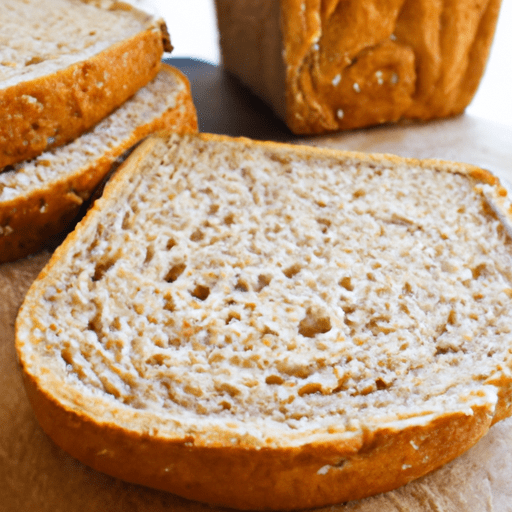The Wonders of Wholemeal Bread
When it comes to wholesome and nutritious bread, wholemeal bread takes the crown. With its irresistible taste, versatile uses, and impressive nutritional profile, this bread variety has become a staple in many households. In this blog post, we will delve into the world of wholemeal bread, exploring its distinctive features and shedding light on its fascinating history.
A Taste to Savor
Wholemeal bread offers a delectable flavor that sets it apart from other types of bread. Its rich, nutty taste adds depth to every bite, making it a top choice for bread enthusiasts. The pleasant texture ranging from dense to slightly crumbly, coupled with its complex earthy notes, makes wholemeal bread a delightfully satisfying experience for your palate.
Versatility Unlimited
Due to its robust flavor and hearty texture, wholemeal bread can be used in a variety of culinary creations. It serves as the perfect foundation for sandwiches, providing a satisfying and nutritious base to complement the fillings. Whether you prefer classic combinations like turkey and avocado or innovative pairings like grilled veggies and hummus, wholemeal bread consistently delivers.
Moreover, this bread variety excels in crafting delicious toasts. Crispy on the outside and moist on the inside, a slice of freshly toasted wholemeal bread is a blank canvas awaiting your favorite toppings. From luxurious spreads like avocado or nut butter to savory options like smoked salmon or scrambled eggs, the possibilities are endless.
A Nutritional Powerhouse
Wholemeal bread truly shines when it comes to its nutritional value. Made from flour derived from whole grains, it retains the bran and germ, resulting in higher fiber content and increased nutrient density. Loaded with essential vitamins, minerals, and dietary fiber, this bread is a smart choice for those seeking a well-rounded diet.
Fiber is one of wholemeal bread’s star qualities, aiding in digestion, promoting heart health, and helping to maintain healthy cholesterol levels. It also helps to regulate blood sugar levels, offering sustained energy throughout the day. Additionally, wholemeal bread is a respectable source of B vitamins, including folate, thiamin, and niacin, supporting optimal brain function and overall wellbeing.
A Journey into History and Fun Facts
Far from being a modern invention, wholemeal bread has been a part of human culinary traditions for centuries. Ancient civilizations, such as the Egyptians and the Greeks, cherished their own versions of this wholesome bread.
Interestingly, wholemeal bread was once considered the bread of the lower classes. The refined white bread made from wheat flour was reserved for the wealthy elite, as it was associated with luxury and refinement. However, with the growing interest in health and nutrition, wholemeal bread has regained its rightful place as a beloved option for all.
In Conclusion
Wholemeal bread is more than just a nutritious choice; it’s a flavorful experience that adds depth and character to your meals. Versatile, packed with essential nutrients, and boasting an intriguing history, this bread variety deserves its cherished place in your kitchen. So, the next time you’re browsing the bakery aisle, be sure to pick up a loaf of wholemeal bread to savor its nutty goodness and enjoy the benefits it brings to your plate and well-being.
Wholemeal bread is a type of bread made using flour that contains the entire wheat grain, including the bran, germ, and endosperm. Here are some interesting facts about wholemeal bread:
Origin: Wholemeal bread has been consumed for centuries, with evidence of its use dating back to ancient times. Historically, it was commonly made by grinding the whole grain of wheat using stone mills or by hand.
Common Uses: Wholemeal bread is widely used for sandwiches, toast, and as a base for various toppings. It is also often used to make breadcrumbs, stuffing, and croutons.
Nutritional Benefits: Wholemeal bread is richer in fiber compared to white bread as it retains the bran and germ of the wheat grain. It also contains higher amounts of vitamins, minerals, and antioxidants. The fiber content helps promote digestion, regulate blood sugar levels, and can contribute to a feeling of fullness.
Unique Properties: The presence of wheat bran in wholemeal bread gives it a slightly denser texture and a nuttier flavor compared to white bread. Due to the higher fiber content, it may have a shorter shelf life and can become stale faster than white bread.
Historical Significance: Wholemeal bread played a significant role in human nutrition before the introduction of roller mills, which enabled the mass production of refined white flour. Historically, it was considered a staple food due to its availability and affordability.
Remember that wholemeal bread can differ slightly in composition and terminology depending on the region. It may also be referred to as whole wheat bread or whole grain bread, although there can be slight differences between these terms when used in specific contexts or regulations.




Use the share button below if you liked it.
It makes me smile, when I see it.